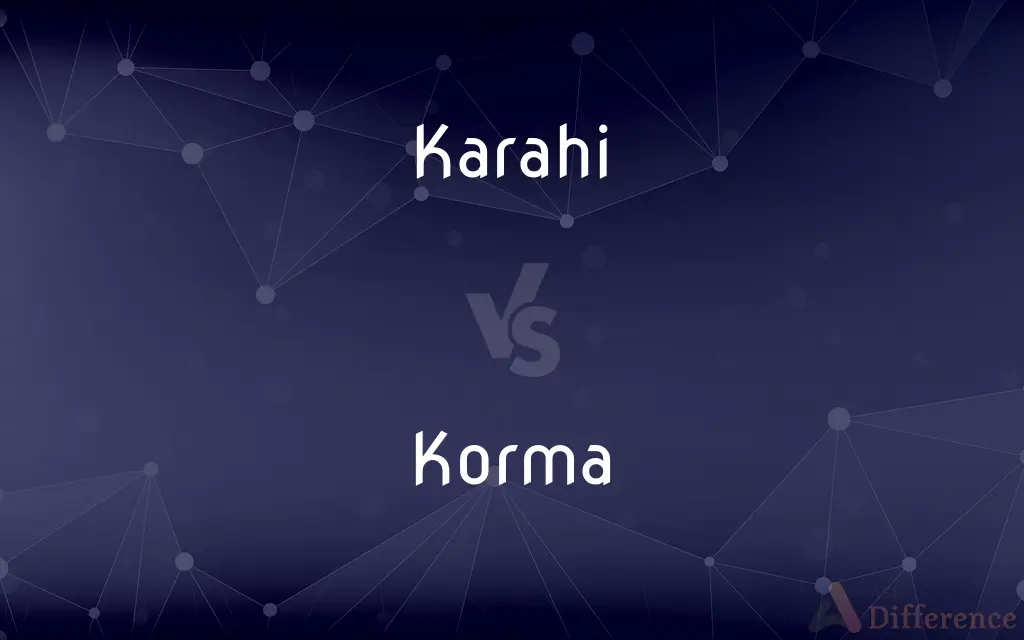Karahi vs. Korma — What's the Difference?
By Maham Liaqat & Urooj Arif — Updated on March 28, 2024
Karahi features a spicy and thick gravy made with tomatoes, while Korma is known for its creamy, mild sauce with nuts and yogurt.

Difference Between Karahi and Korma
Table of Contents
ADVERTISEMENT
Key Differences
Karahi is a type of curry that originates from the Indian subcontinent, characterized by a thick gravy made primarily from tomatoes, ginger, and garlic. On the other hand, Korma is a much milder dish, known for its creamy texture and subtle blend of spices.
Karahi often features a noticeable amount of oil or ghee separating from the gravy, which is a hallmark of its preparation method and adds to its bold flavor profile. Whereas Korma employs a technique known as bhunao, which involves gently frying spice pastes along with meat or vegetables in oil or ghee until they are completely cooked and the flavors are well combined.
The choice between Karahi and Korma often comes down to personal preference for heat and richness. Karahi is preferred by those who enjoy bold, spicy flavors and a hearty, rustic dish. It's often accompanied by naan or roti, which are perfect for scooping up the thick gravy. Korma, with its gentle flavors and creamy consistency, is suited for those with a milder palate and is commonly served with rice or bread, acting as a delicate complement to the main ingredient, be it meat or vegetables.
Comparison Chart
Origin
Indian subcontinent
Indian subcontinent
Base
Tomatoes, ginger, garlic
Yogurt, cream, nuts
ADVERTISEMENT
Spice Level
High
Low
Texture
Thick gravy, noticeable oil separation
Creamy, smooth sauce
Cooking Pot
Cooked in a karahi (round-bottomed pot)
No specific pot required
Flavor
Bold and spicy
Mild and creamy
Garnish
Often garnished with fresh coriander
Sometimes garnished with nuts or cilantro
Serving
Served hot, directly from the pot
Served with rice or bread
Cooking Method
High heat, reduction of gravy
Bhunao (gentle frying of spices)
Dairy Use
Minimal or none
Heavy use of dairy products
Compare with Definitions
Karahi
A spicy curry cooked in a specific type of heavy pot called a karahi.
We ordered chicken karahi from the new Indian restaurant.
Korma
Known for its velvety sauce and subtle spice blend.
The korma had a beautifully balanced flavor, not too spicy.
Karahi
Characterized by its thick gravy and robust flavors.
The karahi was so flavorful, with just the right amount of heat.
Korma
A creamy, mild curry made with meat or vegetables, yogurt, nuts, and spices.
For dinner, we're having chicken korma with rice.
Karahi
Popular in North Indian and Pakistani cuisines.
Karahi is a staple dish in many Pakistani households.
Korma
Often includes ground nuts and dairy to enhance its richness.
The almond paste in the korma added a lovely texture.
Karahi
Often made with meat, especially chicken or goat.
Lamb karahi is a must-try for meat lovers.
Korma
Suitable for those who prefer milder Indian dishes.
If you're not a fan of spicy food, you might like this vegetable korma.
Karahi
Served directly from the cooking vessel.
The sizzling hot karahi was placed in the center of the table.
Korma
A staple dish in Mughlai cuisine.
Korma is one of the jewels of Mughlai culinary traditions.
Karahi
A karahi (; Assamese: কেৰাহী, romanized: kerahi, Bengali: কড়া, romanized: koṛā, Hindi: कड़ाही, romanized: kaṛāhī, Marathi: कढई, Urdu: کڑاہی; also kadai, kerahi, karai, kadhi, kadahi, kadhai sarai, or cheena chatti) is a type of thick, circular, and deep cooking pot (similar in shape to a wok) that originated in the Indian subcontinent. It is used in Indian, Afghan, Pakistani, Bangladeshi, and Nepalese cuisines.
Korma
A dish of South Asian origin in which meat or vegetables are braised or simmered in a rich, highly seasoned sauce thickened with ground nuts, yogurt or cream, and sometimes coconut.
Karahi
A deep circular vessel resembling a wok, traditionally of cast iron, used in South Asian cuisine.
Korma
Korma or qorma is a dish originating in the Indian subcontinent, consisting of meat or vegetables braised with yogurt (dahi) or cream, water or stock, and spices to produce a thick sauce or gravy.
Karahi
A kind of curry or stew prepared in such a vessel.
Korma
A curry made from various spices especially coriander and cumin; and often with yoghurt sauce or nuts.
Common Curiosities
What type of meat is commonly used in Karahi?
Chicken, goat, and lamb are the most common meats used in Karahi.
How long does it take to cook Karahi?
Karahi usually takes less time to cook compared to slow-cooked dishes, depending on the meat used.
What is the main difference between Karahi and Korma?
Karahi is a spicy dish with a thick tomato-based gravy, while Korma is a creamy, mild curry made with yogurt and nuts.
What is the best way to serve Karahi?
Karahi is best served hot, directly from the pot, with naan or roti for scooping up the gravy.
Can both Karahi and Korma be vegetarian?
Yes, both can be made with vegetables instead of meat, catering to vegetarian preferences.
Is there a dairy-free version of Korma?
Dairy-free versions of Korma can be made using coconut milk or almond milk instead of traditional dairy.
Can Korma be made without nuts for those with allergies?
Yes, Korma can be adapted to exclude nuts, using alternatives like seeds or nut-free cream to maintain its creamy texture.
What kind of spices are used in Korma?
Ground coriander, cumin, turmeric, and sometimes mild korma spice mixes are used in Korma.
Is Korma considered a healthy dish?
While Korma contains healthy ingredients like nuts and yogurt, its high dairy content can make it richer and higher in calories.
Which is spicier, Karahi or Korma?
Karahi is typically much spicier than Korma.
Share Your Discovery

Previous Comparison
Plutocracy vs. Fascism
Next Comparison
Credit vs. FameAuthor Spotlight
Written by
Maham LiaqatCo-written by
Urooj ArifUrooj is a skilled content writer at Ask Difference, known for her exceptional ability to simplify complex topics into engaging and informative content. With a passion for research and a flair for clear, concise writing, she consistently delivers articles that resonate with our diverse audience.















































